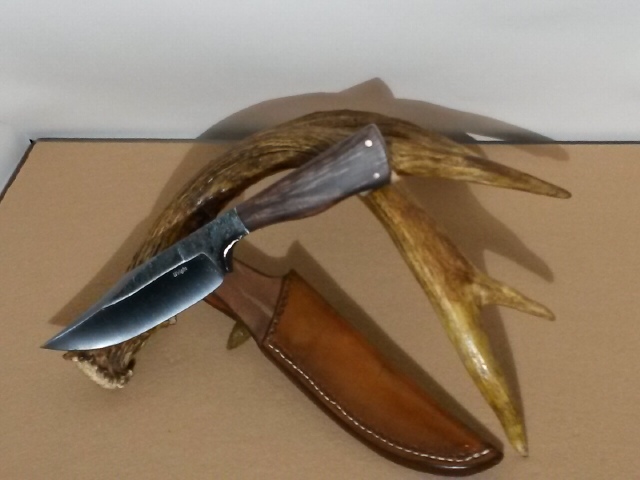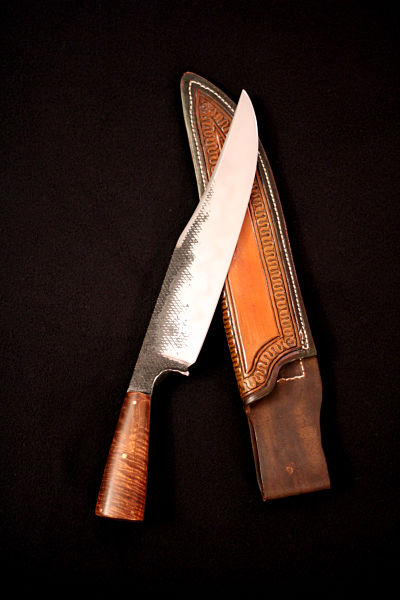The Topic of the Month for August 2016 is, Brut De Forge Knives. The term for this style of knife was made popular by Master Bladesmith Joe Keeslar. Brut de forge knives are typified by having rough forged areas left on the blade.
Please post your tips, techniques and photos of your brut de forge knives. Also important are design aesthetics for this style of blade. Is there a visually correct ratio of rough forged vs. finished area on a brut de forge blade?
Great Topic of the Month for August 2016, Steve!
Yes, Master Smith Joe Keeslar is well known for this style of forged knife. Below is a photo and description of the 2013 ABS Board of Directors Knife that Joe Keeslar made and donated for 2013 ABS Knife Auction at the Atlanta Blade Show.
[center]

Joe’s knife is called the BEN LILLY BEAR KILLER. It was inspired by the 19th Century hunter, tracker and guide, Ben Lilly. He was born in 1856 in Alabama and followed the bear and panther westward through Mississippi and Louisiana to Texas, leaving a trail of stories about his prowess as a hunter and his goodness as a man. He was "chief huntsman" to Teddy Roosevelt, hunting in Texas and Mexico, and came to be known as the master sign reader of the Rockies. From time to time he would stop and forge a knife at a blacksmith shop during his travels; his knives were made from old files. He has been referred to by many as the "Last of the Mountain Men". There have been numerous books written about Ben Lilly one of which will accompany Joe’s incredible knife. This "Ben Lilly Bear Killer" is Joe’s interpretation of one of his knife blade designs, with my Brut de Forge integral guard and handle.
The knife is forged from a 19th Century French rasp cut file with an overall length of 15 inches and a 10 inch blade. The handle is of presentation grade curly maple. The left side of the handle is inlaid with a sterling silver medallion depicting my 50 years as a bladesmith (1962-2012). The remaining left side of the handle is inlaid with sterling silver wire in "S" and "C" Scroll design. The right side scale of the handle is inlaid with sterling silver, copper, and brass wire in the design of the American Bladesmith Society logo, i.e. anvil, knife, flames and the letters ABS. The remainder of the right scale is covered in "S" and "C" Scrolls in sterling silver wire.
The Bolsters are of #416 stainless and engraved with a "Dragon Scale" design. The spline of the blade has decorative file work and is engraved in "The Vine" pattern. There is also decorative file work and engraving on the pommel end of the tang of the knife.
The sheath is of 8 oz. tooling leather with a 4 oz. leather liner made in a Southwestern design. It is tooled in a basket weave pattern with a large Concho on the front of the sheath.
[/center]
Dan Cassidy
Journeyman Smith
Send an email to Dan

I am no Joe Keeslar, but I love his brute knives and have been working on this style all summer to try and improve my smithing skills. Here is what I have been up to:

1084 and stabilized walnut

1084 and elk antler

1084 - sterling silver and brass

1084

1084

An unfinished one in 1084
I like taking these to an extreme sometimes, I will forge 98-100% to finished shape with just the edge being cut in after forging and as little fileing or grinding done as is possible. I find it is a fun challenge to forge that thin. I did a Video a few years ago on my method, https://www.youtube.com/watch?v=16Y6OwU3-UU
[media] http://www.youtube.com/watch?v=16Y6OwU3-UU [/media]
MP
I have found that many makers use the term Brute de Forge rather loosely and use it to describe nearly any knife that still has forge scale on it - even if this was not the result of forging, but simply from forge atmosphere.
Karl B. Andersen
Journeyman Smith
To me, a true Brut de Forge is one forged in the manner of the original by MS Joe Keeslar. I watched Joe's demo at one of the hammer-ins at Old Washington a couple of years ago. I bought the well written book on forging the Brut de Forge, which is available in the ABS Store section. They are fun to make, and sell very well. I generally put a hollow grind on Bruts. If I'm forging one with the intent of producing a hamon, I'll do a flat grind.
Having a good post vise for forging in the guard is most helpful. This is one place I deviate, I use a Oxy/Acet torch to apply constant heat while hammering in the guard. I also block up under the steel to keep from having to re-adjust it in the vise while forming the guard. I use a dinging hammer to form the guard, and I modified a cross pein for forming the guards on larger knives.
I'll use copper, brass or nickel silver for the liners and pins.
If you haven't made this style of knife, give it a try!
Bob
|quoted:
To me, a true Brut de Forge is one forged in the manner of the original by MS Joe Keeslar. I watched Joe's demo at one of the hammer-ins at Old Washington a couple of years ago. I bought the well written book on forging the Brut de Forge, which is available in the ABS Store section. They are fun to make, and sell very well. I generally put a hollow grind on Bruts. If I'm forging one with the intent of producing a hamon, I'll do a flat grind.
Having a good post vise for forging in the guard is most helpful. This is one place I deviate, I use a Oxy/Acet torch to apply constant heat while hammering in the guard. I also block up under the steel to keep from having to re-adjust it in the vise while forming the guard. I use a dinging hammer to form the guard, and I modified a cross pein for forming the guards on larger knives.
I'll use copper, brass or nickel silver for the liners and pins.
If you haven't made this style of knife, give it a try!
Bob
That is a nice looking knife Bob!
Thanks Jim!
When I started making knives in 2002 Joe was my first instructor. While there he forged a brute de forge hunting knife blade. At the time, I got the impression that I should be working on fit and finish instead of rough forged finish. He was probably the one who told us that. But his brute methods stuck with me. I think it was probably years before I attempted to make one like he did.
Now I use variations of what he taught me on a lot of knives.
I think some who are just getting started into forging think that a brute de forge is a short cut to a completed knife. But I've found them to be every bit as time consuming. When making one, I spend a lot more time at the anvil and have to forge things even and straight to a higher degree. Plus, where the brute finish might meet the hand, the smith has to hammer finish better. This serves to teach better hammer and temperature control.
Here's a tip for finishing a brute finish: When bringing the blade/knife out of the oven after the first draw cycle, smear straight linseed oil on the areas remaining forged finish and then do your second cycle. It will form a varnish on it and even the colors out to a nice dark look.
Lin,
You are correct about forging a Brut. It can be very challenging keeping the spine and tang straight after forging in the guard. I like to get everything back straight before continuing as it seems to make it easier to keep it straight while forging the blade area.
Bob
Those are really nice Karl!
Bob
All my life changed wen i met him in Thiers, some years ago. He is not just one o the best knifemakers. It is the best person I 've ever met. I always tell him that he is my "father knifemaker". And the 99% of my knives are inspired on his job.















